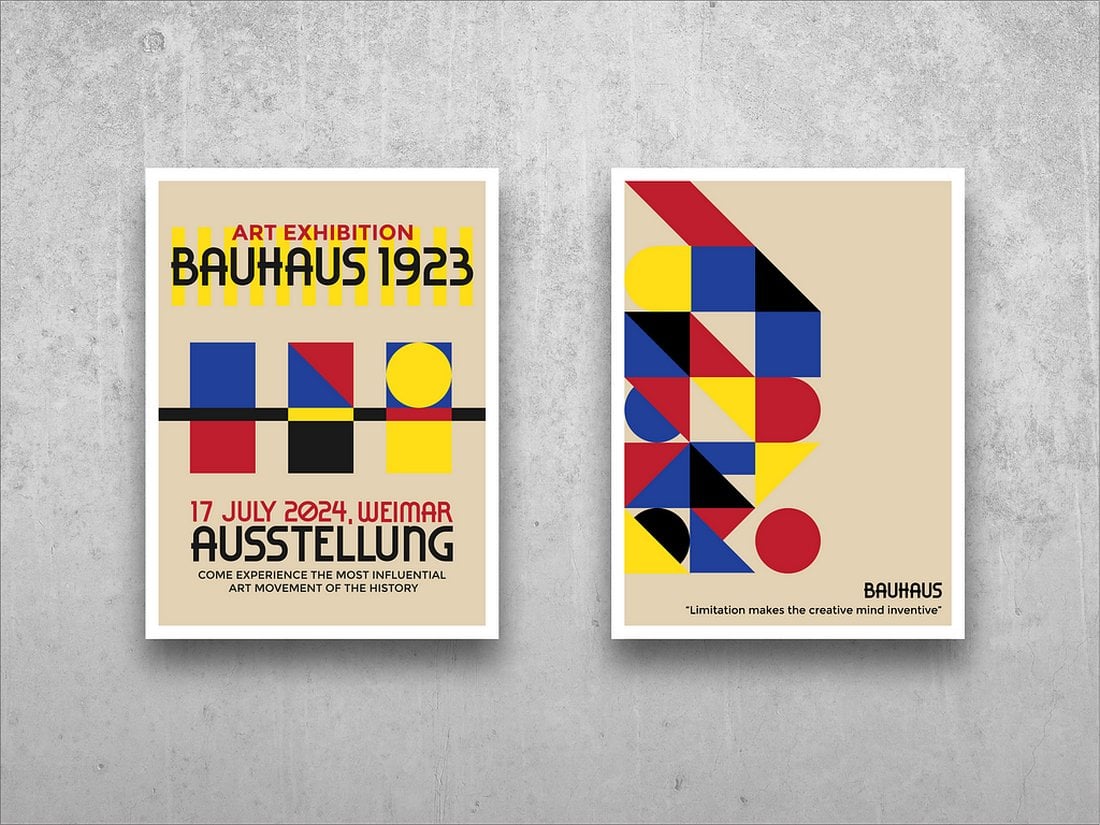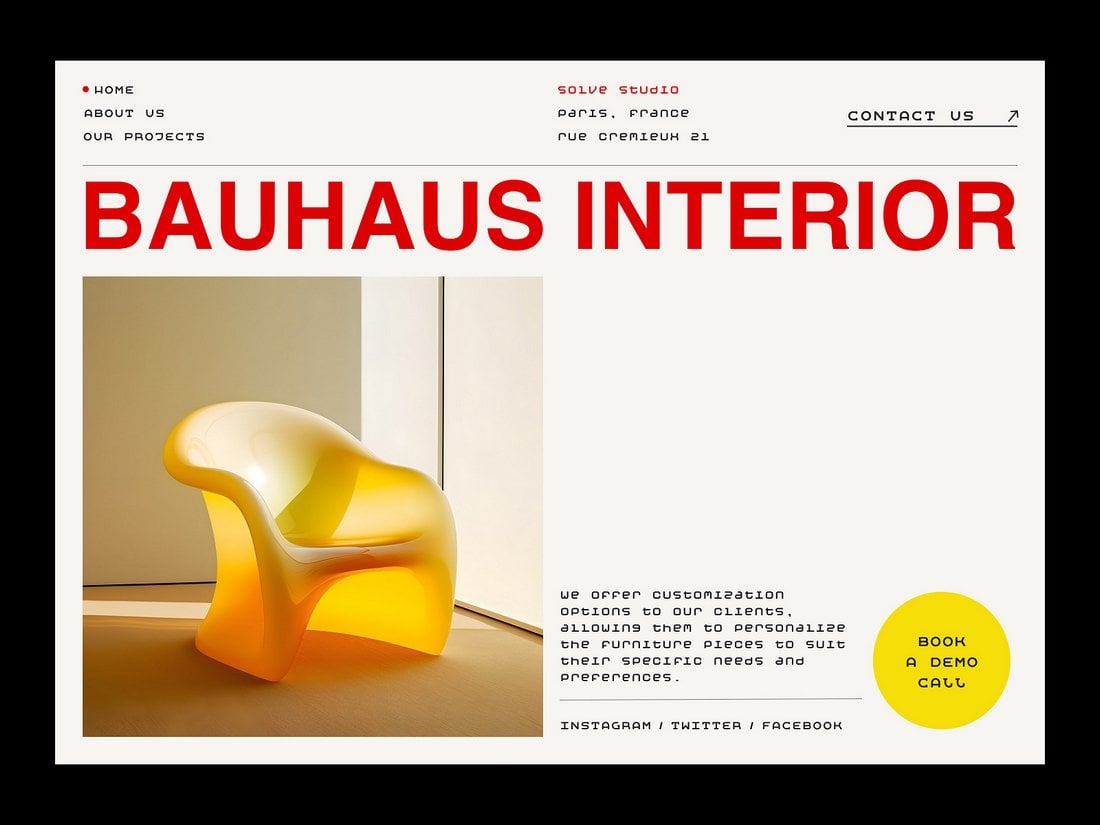What Is Bauhaus Graphic Design? Inspiration & Examples
Bauhaus is one of the most popular design trends known for its unique, abstract style that has inspired many creative designs from brand identities to marketing materials and more.
The Bauhaus design style is nothing new. In fact, its’ history dates back to 1919 involving an art school in Germany.
In this post, we take a closer look at the Bauhaus design movement and its impact on today’s graphic design industry. We also found many Bauhaus-themed designs for your inspiration to help you get a better understanding of the current trends.
Let’s dive in.
Origins of Bauhaus Design

(Source: Wikimedia)
The Bauhaus design movement originated in Germany when an architect named Walter Gropius launched a design school with the same name. The word Bauhaus means “house of building,” which Gropius invented by inverting the German word Hausbau, which means “building of a house.”
Back then, the Bauhaus design school was a sensation among designers, well-known for its wild training programs, bizarre parties, and philosophies. But it was also the birthplace of some of the most unique furniture, architecture, and graphic designs.
The school had a very short lifespan which lasted only until 1933. However, that short time period was enough for this school to inspire many generations. To this day, the Bauhaus design movement is recognized as one of the most creative styles in the industry.
Impact on Modern Graphic Design
If you look around your home or office, you will likely see products and designs inspired by the Bauhaus movement, whether it’s a stylish office chair or a teapot.
It also made its way over to the print and digital worlds of design by inspiring designers to create patterns, logos, and even user interfaces following the same principles of the Bauhaus movement.
Main Characteristics of Bauhaus Graphic Design
The fascinating architectural designs and the eccentric furniture designs created by the Bauhaus school students inspired many other branches of design. And graphic design was at the core of all these fascinating projects.
Today, you can recognize a Bauhaus-style design instantaneously by its unique characteristics.
Use of Geometric Shapes

(Source: Anastasia Doroshenko)
Basic geometric shapes such as squares and circles take center stage in every Bauhaus-style graphic design. Bauhaus-inspired designs often emphasize simplicity and the use of basic geometric shapes is part of that process.
Asymmetrical Compositions

(Source: Amany Alshalatoni)
Even though the use of geometric shapes is common in Bauhaus graphic design to achieve simplicity, symmetry is not part of that concept. Creative yet balanced asymmetrical compositions are the main feature that often defines Bauhaus-inspired design projects.
Color Themes

(Source: Helena)
You won’t see fancy gradients used in Bauhaus-style designs. Instead, Bauhaus designs use combinations of primary colors with black and white to create high-contrasting visuals that instantly attract attention.
This style of flat color design is not just about simplicity but also about making designs easy to print and reproduce. Even though digital design makes those redundant, the same color theories are used in modern Bauhaus-inspired design projects for their bold, striking looks.
Grid-Based Layouts

(Source: Adam Limanowski)
Proper structure is another key feature of Bauhaus design. For this, Bauhaus designs often use grid-based systems to create well-structured and balanced designs. It not only creates an aesthetic look but also plays a role in functionality as well.
Sans-Serif Typography

(Source: Christopher Andrew)
At a time when serif and blackletter typefaces dominated typography design, the Bauhaus school opted to use simple, sans-serif fonts as it played well with its simple approach to graphic design. Even today, sans-serif fonts are the acceptable choice for typography in Bauhaus-inspired design projects.
Examples of Bauhaus Graphic Design
The Bauhaus movement has influenced many different areas of both print and digital design. These examples show how the Bauhaus style makes each design stand out on its own.
Bauhaus Brand Identity Design

The Bauhaus-style brand identity designs are popularly used by various digital startups and agencies to showcase their commitment to simplicity and minimalism. The colorful shapes and patterns help create an aesthetic look for these branding designs as well.
In this example, you can see how a cloud data management company has adopted the Bauhaus design style to showcase its creativity and smart technologies.
Bauhaus Poster Design

When it comes to poster designs, the Bauhaus trend offers more of a stylish and decorative look. It’s more about aesthetics and creative choice than functionality. As a result, it’s mostly used by brands for making bold statements.
The example above is a poster design for a student magazine called Forma.
Bauhaus Website Design

Bauhaus style influence in web design can be seen in various forms. Some designers would incorporate Bauhaus illustrations and patterns into their websites while others go as far as to use Bauhaus as a theme to create entire websites inspired by the design movement.
The example website design you see here is for an interior design company, which fits perfectly with the Bauhaus design style.
Bauhaus Packaging Design

Whether it’s a grocery bag, box packaging, or a drink bottle label, Bauhaus has influenced many different types of packaging designs, featuring Bauhaus-themed geometric shapes and colors combined with unique typography.
This example shows how a beer brand called Baubeer has adopted a creative Bauhaus-themed packaging design for its beer bottles.
Bauhaus Logo Design

Many brands have found inspiration from Bauhaus design to create unique logos. Especially when crafting emblems and icons, this design style offers a way to create a fresh and modern look for a brand.
The MMT Coffee brand identity is a great example that shows how to craft a logo inspired by the Bauhaus style.
Bauhaus Fonts

Over the years, Bauhaus has inspired movements in typography and it’s now inspiring designers to create unique fonts as well. These fonts incorporate Bauhaus-themed asymmetrical shapes and colors into letterforms.
The example above is an actual font you can download from Envato Elements to use in your design projects.
Conclusion
Having an understanding of the Bauhaus design style and movement is essential for all types of designers as it provides you with a framework for crafting designs that are both functional and stylish.
The Bauhaus movement and its boundless impact on graphic design is immeasurable. Over the past hundred years, this movement inspired many new products, trends, and styles that we are still using today. And it will continue to inspire more for many centuries.